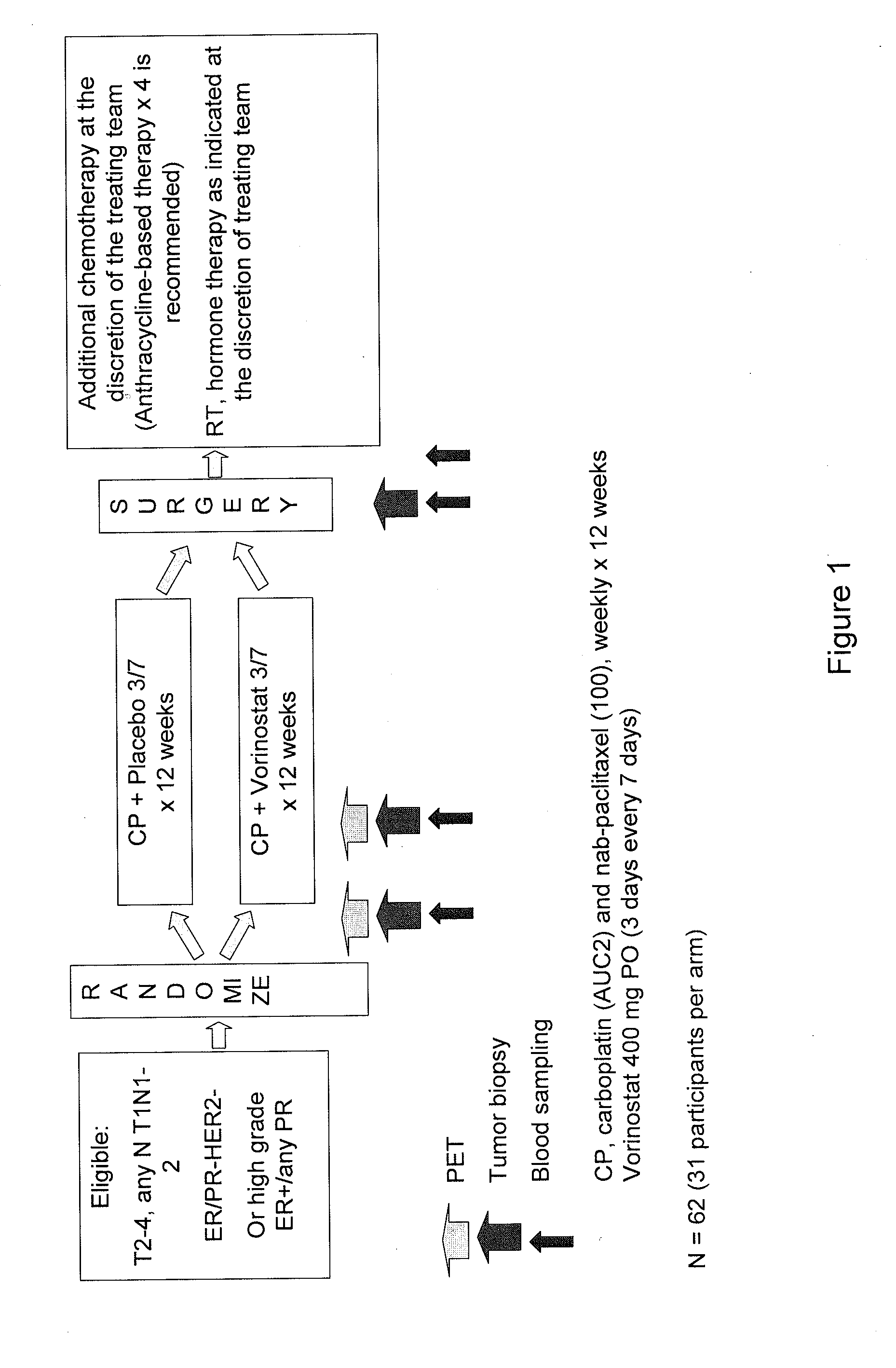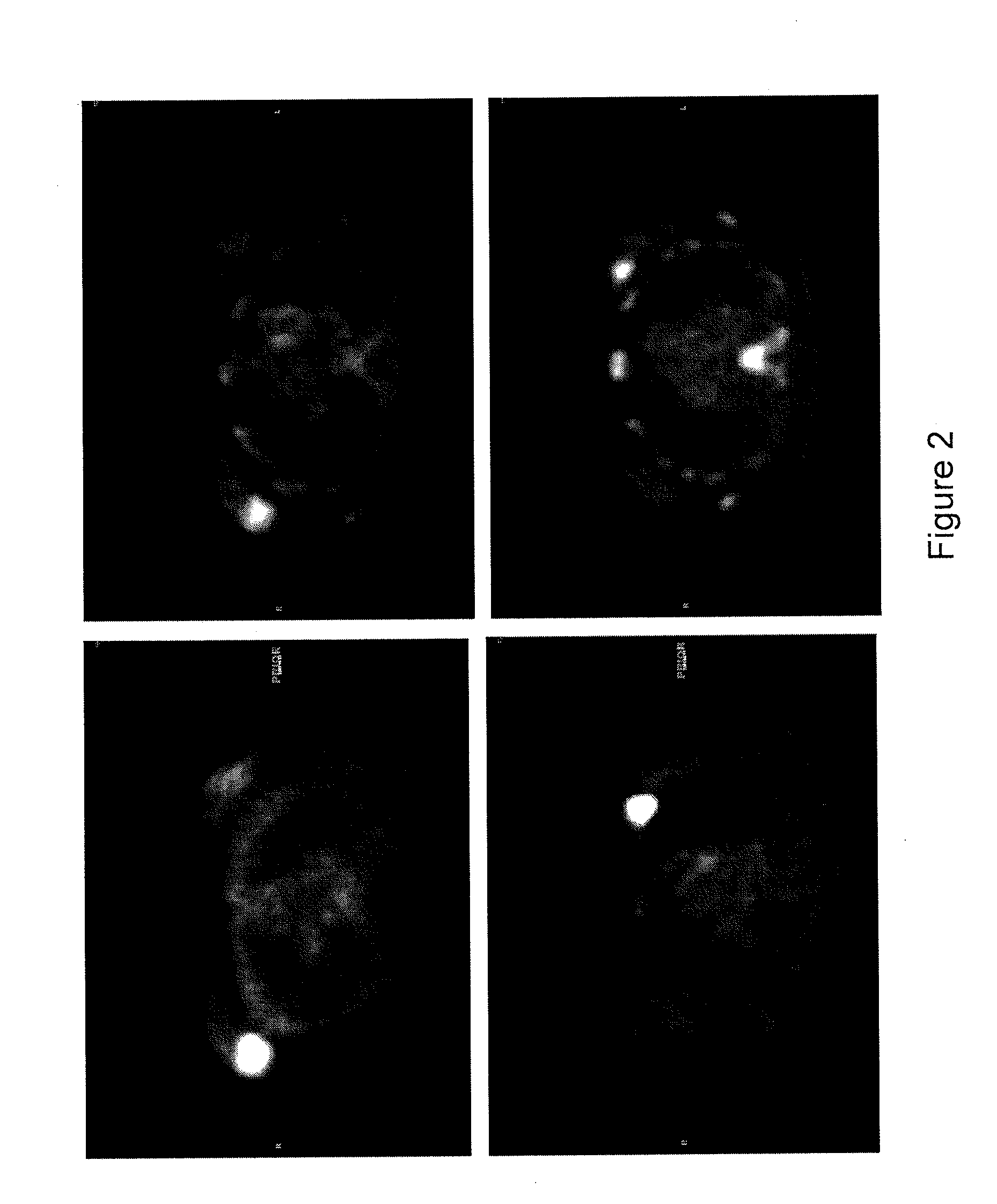Combination therapy methods for treating proliferative diseases
a technology of proliferative diseases and conjugated therapy, which is applied in the direction of biocide, drug composition, animal repellent, etc., can solve the problems of gene silencing, most prevalent forms of cancer still resist chemotherapeutic intervention, and generally unresponsive to standard receptor-mediated treatmen
- Summary
- Abstract
- Description
- Claims
- Application Information
AI Technical Summary
Benefits of technology
Problems solved by technology
Method used
Image
Examples
example 1
Treatment with Carboplatin and Nab Paclitaxel (CP) with or without Vorinostat in HER2-Negative Primary Operable Breast Cancer
[0290]This study included both a run-in phase to investigate the safety of 12 weekly doses of carboplatin (“C”) (AUC 2) and nab-paclitaxel (“P”) (100 mg / m2) with vorinostat 400 mg orally (“po”) daily (first 3 out of every 7 days) in women with unresected stage II-III HER2-negative breast cancer and a randomized phase II portion. The purpose of the randomized double-blind phase II study was to evaluate response and surrogate biomarkers to carboplatin and nab-paclitaxel (CP) with or without vorinostat as preoperative systemic therapy (PST) in HER2-negative primary operable breast cancer.
[0291]The primary objective of the study was to evaluate the primary pathological complete response rate (pCR). The secondary objectives of the study were to evaluate the safety of these regimens in these patients; to evaluate the clinical response rates; to correlate baseline an...
example 2
Evaluating Response and Surrogate Biomarkers to the Treatment with Carboplatin and Nab Paclitaxel (CP) with or without Vorinostat as Preoperative Chemotherapy in HER2-Negative Primary Operable Breast Cancer
[0296]This randomized double-blind phase II trial studies the effects of the treatment of carboplatin and paclitaxel albumin-stabilized nanoparticle formulation (nab-paclitaxel) with or without vorinostat in women with breast cancer that can be removed by surgery. In addition, this study evaluates the response and surrogate biomarkers to the treatment with carboplatin and nab-P (CP) with or without vorinostat.
[0297]There are two arms for this study. Arm I is Active Comparator: patients receive carboplatin intravascular (“IV”) and paclitaxel albumin-stabilized nanoparticle formulation IV on day 1 and an oral placebo on days 1-3. Treatment repeats weekly for 12 weeks in the absence of disease progression or unacceptable toxicity. Drug used for Arm I are: carboplatin given IV; paclit...
example 3
Using FDG-PET Prior to Neoadjuvant Therapy and Post Neoadjuvant Therapy to Predict Response to the Therapy in Breast Cancer Patients
[0306]This study used functional imaging, FDG-PET, to predict response to neoadjuvant therapy in patients with early stage breast cancer. For the patients with early stage breast cancer, FDG-PET was performed at baseline and 7 days after commencement of neoadjuvant therapy in women with early breast cancer. FIG. 2 shows the FDG-PET results from 2 patients. Patient 1 (top, FIG. 2) had a right-sided breast mass (Standardized Uptake Value (“SUV”) of 12.4) prior to neoadjuvant therapy and a reduction in SUV to 6.7 based on FDG-PET. Patient 1 had a partial response to the therapy. Patient 2 (bottom, FIG. 2) had a left-sided breast mass (SUV of 31) prior to neoadjuvant therapy and a reduction in SUV to 9.9 based on FDG-PET. Patient 2 had a complete response to therapy.
PUM
| Property | Measurement | Unit |
|---|---|---|
| diameter | aaaaa | aaaaa |
| diameter | aaaaa | aaaaa |
| diameter | aaaaa | aaaaa |
Abstract
Description
Claims
Application Information
 Login to View More
Login to View More - R&D
- Intellectual Property
- Life Sciences
- Materials
- Tech Scout
- Unparalleled Data Quality
- Higher Quality Content
- 60% Fewer Hallucinations
Browse by: Latest US Patents, China's latest patents, Technical Efficacy Thesaurus, Application Domain, Technology Topic, Popular Technical Reports.
© 2025 PatSnap. All rights reserved.Legal|Privacy policy|Modern Slavery Act Transparency Statement|Sitemap|About US| Contact US: help@patsnap.com



